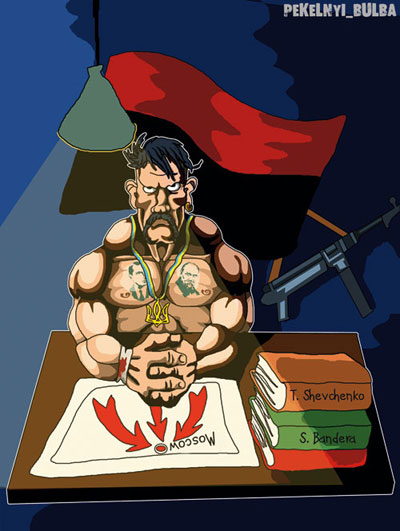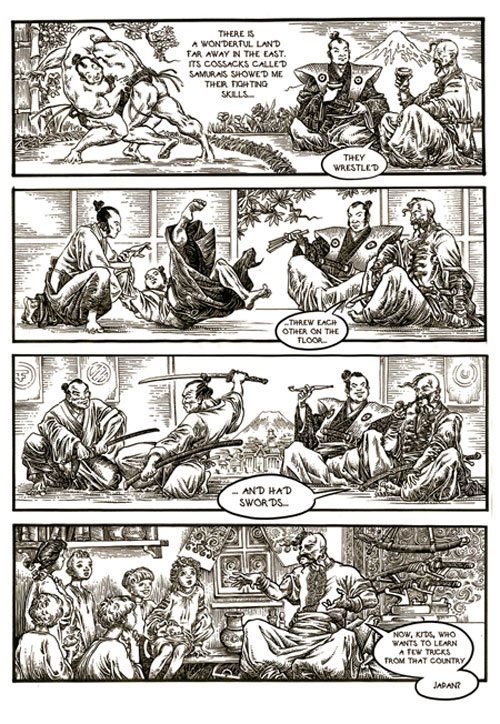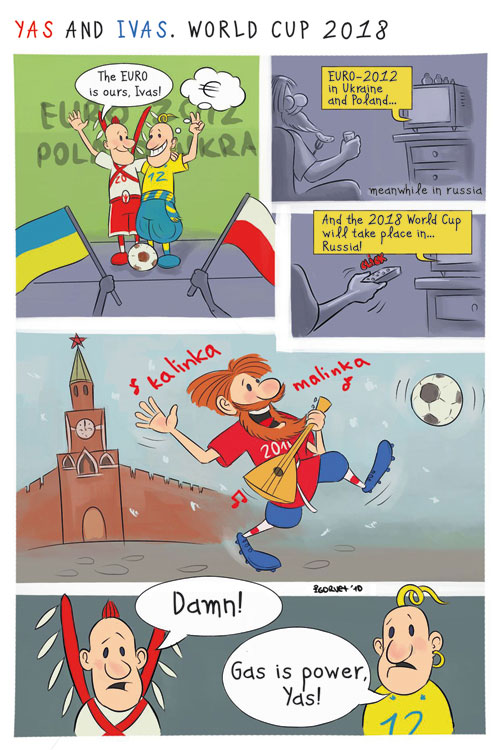The term “comic”has the hint of something comical and therefore light-hearted, which is the reason for its relevant perception as light reading material for teenagers. Skeptics would be surprised if they looked into the past saw that one of the first “drawn stories” was made in a Japanese convent in the 12th century. It was the Buddhist monk, Toba (or Kakuyū), who illustrated four humorous stories. Two of them were about animals imitated by people, while the other two ones were about monks violating rules, particularly their participation in cock-fights. The basics of the genre in its modern form, namely movements and gestures, were taken from these first works.
“Comic” is a common term for “funny”, says painter Oleksiy Chebykin, although of course, not all these stories are funny. The European standard classification is that comics are only published in the US. The French use the term “bande dessinée” meaning a “strip of paintings”; the Japanese call them “manga” etc. Each nation has its own product with an individual name and origin. It is only the method of conveying information that is common – all the rest is completely different”. Ukrainian experts of this genre refer to them as “graphic novels”.
A “message” conveyed professionally in the form a of comic, can play the role of a perfect driving force or even a tool of influence. “I used to teach in school,” says Vitaliy Sichkarchuk, also known as Infernal Bulba. “Comics helped me illustrate certain examples for my students. This genre is unique and undemanding, no special training is required for it. Of course there are highly technical comics, but at the same time, it is possible to draw something really primitive in terms of technique and people will still accept it!”
FROM CAVE TO TEMPLE
In Chebykin’s view, comics have their origins in cave paintings. Ancient people tried not only to draw a picture, but also show a story, it was a chain of events describing the animal chase, for instance. “In all likelihood, the first inscriptions transformed into hieroglyphs and ancient fonts, he says, as for the Egyptians, they painted actual comic strips! Or take Chinese inscriptions, the hieroglyph for a “house”really looking like a house, and a hieroglyph for a “man” is made up of a “trunk, arms and legs…”. Greece gave us the tradition of painting hagiographies around icons! Looking at local church paintings, it’s possible to read almost the whole Bible. They are a combination of a Saint’s image and an accompanying text”. The tradition of “illustrated novels” (so named by French surrealist Georges Sadoul), dates back to the 16th or 17th centuries, when drawings, largely of a religious nature, were distributed among common people in Barcelona and Valencia. These were hagiography texts in the form of imprints of tiny engravings on coloured paper, called “hallelujahs”. In time, they were mass-produced at factories.
The modern form of graphic novels became popular in Europe and the US almost simultaneously, but the more practical Americans were the first to establish a commercial basis for them. The first business comic was made up of stories entitled Yellow Kid. “Asian tradition was quick to penetrate Europe and the US”, mangaka (the term used for Asian comic painters), says Anna Isayenko, mangaka (the term used for Asian comic painters), known as Sakura. That is her nickname and most mangakas have one. “The Japanese school is called manga, in Korea it’s called manhwa, in Taiwan –manhua, etc.”
Just like in anything else, the Japanese stick to traditions, when creating comics. Mangas are still painted in ink, they are black and white and the drawings are presented in a back to front order, according to the rules of local orthography. By the way, authors usually insist on the same order in translated editions, saying that it is crucial for the proper perception of the story.
COMING OUT OF THE UNDERGROUND
The art of graphic novel art is developing rapidly in Ukraine, but comics are rarely widely circulated. Currently the painters of comics that The Ukrainian Week has spoken to, see only two means of survival. The first is to “go” to Russian publishing houses, because domestic versions of this genre are literally not published in their pure form in Ukraine. The second is to hide in the art underground, which is blossoming on the Internet and in independent duplication. “Many artists work with Russians and I plan to do so as well,” says Anna – “it’s not about the money, I just want to do what I love. They look for authors, while we have plenty of them, but there’s no room for publishing comics”. This artist thinks Ukrainian publishers do not want to risk with an experiment of this sort, even though it promises them profit. She is convinced that comics spark interest, but publishers are very cautious about them.
“Ukrainian language comics are generally more prevalent in underground publishing houses, as unfortunately, official publications prefer Russian-language products, the same applies to the mass media and cinematography,” says Chebykin. “In our country it is still common to consider the Russian Federation as a broader market, therefore it is more economically viable to publish everything in Russian, so that it can be sold both at home and abroad.”

In view of the obscure status of local graphic novels it is too early to talk about Ukraine`s own comic school. But Infernal Bulba believes that this could also be our advantage. “The absence of a school has its benefits, as there are no limits,” he stipulates. “Maybe this will influence the development and the establishment of a unique trend in Ukraine.” Still, according to Oleksiy Chebykin, a Ukrainian graphic novel school is emerging nevertheless. “Our school really differs from those in France, Russia, Moldova … It’s difficult for me to characterize its distinctive features… The difference is in the graphic material. The Ukrainian graphics school has always been different and separated from the European school, although that is where its roots lie. The first representatives of this school studied in Germany, namely at the Munich Academy. Many of them gained their knowledge in Russia, from artists who studied in Italy. Lviv has its own particular situation, since its residents had close relations with Poland and Germany until 1920, which is noticeable in its art… Kyivan-Rus provided art with symbiosis, with the Greek school of the Byzantine Empire combined with Scandinavian minimalism and structure. Later we had “realistic baroque” in which the image was closely linked to decorative interpretation, which is where the naïve artists we know come from. Ukrainian graphic art is close to the Latin American.”
BEYOND SUPERMAN
This genre was already known in Ukraine before the latter became acquainted with the term “comic” and examples of graphic novels from Europe. Graphic and illustrator, Heorhiy Malakov, is one of its leading figures. As a child he invented several models of this genre –he lived in Kyiv during the Nazi siege, imagining a hero and drawing stories about war… Famous artist Ihor Vyshynskiy, who illustrated many children’s books, also created actual comic strips about his friends and fellow-artists. He created images for them, funny situations, painted a fictional country in the center of Europe where people from different nations lived. This work was made up of more than 300 pages. Currently, his wife has the original and his friends have photocopies. An example of a “graphic novel” is the book Ukraine`s Battle, which tells the history of the Ukrainian Insurgent Army (UPA). This booklet is actually a successful reprint of material from 1953 in Philadelphia, a newspaper published in the diaspora (USA).
“As you know, at present, the book business in Ukraine is not very strong,” says Oleksiy Chebykin. “A 50-page graphic novel requires at least six months of work. I can imagine the royalty amount that the artist should receive. Is there a publishing house in Ukraine that is ready to pay him and the author for this period? In addition, the work I am doing now is only the outline. Someone has to colour it in, an editor is also required… All of this is pretty expensive. Painters who are serious about their art, have stopped waiting for terms and orders, they simply draw. This was the path taken by Poland, where the first comics were made on a Xerox and sold almost for free.”
The story of Cossack Maksym, the Wasp by Ihor Baranko, one of the most prominent artists in this genre, made the long journey from a Belgian publishing house, which published it in French, to Poland, before coming to Ukraine, where it was first published in Russian and only later in Ukrainian, on the demand of fans. “This story is written in a classic noir detective story style,” Chebykin says. “Now everyone is waiting to see whether Ihor will continue the adventures of his cossack.”
One of the first works by Oleksiy Chebykin entitled Noviy Borysfen (“New Borysthenes”) was a fantasy reinterpretation of Kyivan-Rus history, the principal characters being Prince Volodymyr, epic hero Dobrynya and Princess Olha… “When this story was published, people were obsessed with J.R.R.Tolkien and I was pleased to discover that tolkienists were interested in “Borysfen,”says the artist. “When a young artist says “I’ll draw a story of Chicago,” I ask “Have you been there? Do you want a gangster story? Well, we have Troyeshchyna… Do you think Chicago is scarier?” In historical plots there’s always Japan and samurais, because “It’s cool!” What about our Cossack Sirko, riflemen, epic heroes, Cossacks… The list is never-ending! I have been interested in history since I was a kid. All these Teutons, Knights, King Arthur, the Holy Grail… But in time, I understood that this was only good presentation! I want to make kids not only play the musketeers, but also Cossacks! I want to make Cossacks as interesting as Japanese ninjas! The Asian cinematographer gained success via martial arts! They made a legend out of wu shu, while in fact it is only a fight! I’d like children to know that Cossacks are not limited to men dressed in sharovary, the traditional baggy trousers. I want them to know that they are cooler that knights, musketeers or ninjas! It could be a new worldwide brand.”
“We have a vast space that needs to be filled, great potential, an incredible number of our own superheroes!” Bulba believes. “Superman, Batman, the Ninja Turtles… Meanwhile we have a lot to play with, we have our own characters!”
“I once received a proposal to design calendars and during the meeting, the client, a very well-known man, stated that he was a fan of my creative work,” says Infernal Bulba. “I was both pleased and shocked, since I never thought that such people would read my comics. Maybe this means that there is a shortage of certain kinds of literature; the field of humour is scarce in Ukraine. We only see one style on TV – stand-up jokes. Having a limited choice, people enjoy anything. I can’t see any obstacles for the circulation and development of this genre! There is plenty of room for movement and everyone can find their own niche.”
DIFFERENT TYPES OF COMICS
Silent comics
Graphic novels do not necessarily contain text, there are “silent comics” with a graphic description of the plot, so that there is no need for words. Arzak by Moebius (Jean Giraud) is one of the most famous comics of this type.
Photocomic
Photocomic is a different type of comic, although not all authors and painters of traditional graphic novels recognize it as such. In a comic of this sort, photos serve to convey the plot instead of drawings. Famous actors, toys or the most well-known Internet memes can be characters in these stories. Work on photocomics became a basis for the plot of The White Sheik, the first full-length film by Federico Fellini.
COMICS IN THE WORLD
Manga
“Manga” means grotesque or “fanciful drawings”, though their genres may be really different, ranging from children’s stories or fantasy to horror, erotica, politics or business stories. In Japan manga makes up nearly a quarter of total printed output, all the publishing houses have relevant departments, while the profession of a mangaka is highly respected. In addition to professional mangas, there are also dōjinshi, amateur comics, published at the author’s expense. Many respected mangakas started their careers with dōjinshi. A typical stereotype related to the mangas, are the notorious “large eyes”. First of all, not all Japanese comic characters have really large eyes; secondly, large eyes were copied from American cartoons. Osamu Tezuka was inspired by animated films about Betty Boop, in which the lead character is a girl with large eyes. Later, other mangakas caught on to the trend and large-eyed characters became a mainstream style. However, in addition to this, there are also photorealistic, grotesque and other styles of drawing.
American comic
The first US comic, The Little Bears was published in The San Francisco Examiner in 1892. The comic strip quickly became a “trademark” of editor, William Randolph and was adopted by his competitor, Joseph Pulitzer. Hogan's Alley by Richard F. Outcault was the first “mass” comic to make the genre a commercial one. The lesser character, a boy dressed in a yellow outfit, was really loved by readers and the author made him a lead character. Superman, Batman, Spiderman, Captain America and other superheroes appeared (and some of them were even born) in graphic novels. The comic genre even drew the attention of Stephen King who created a story about the first American vampire.
French BD (bandes dessinées)
It is one of the oldest European traditions of this genre, with its own school and numerous followers throughout the world. It is worth mentioning some cult authors: Jean Giraud, known as Moebius, Alejandro Jodorowsky, Albert Uderzo, Hergé (Olivier Ledroit). The latter two have gone down in history as the authors of humorous and children’s comics (they created such characters as Tintin and Astérix), the others are known for their avant-garde phantasmagoric works with a hint of craziness, lots of adventures, erotica, adventures and gloomy pictures of the future. By the way, French artists of the genre drew a comic based on the story of Taras Bulba.




